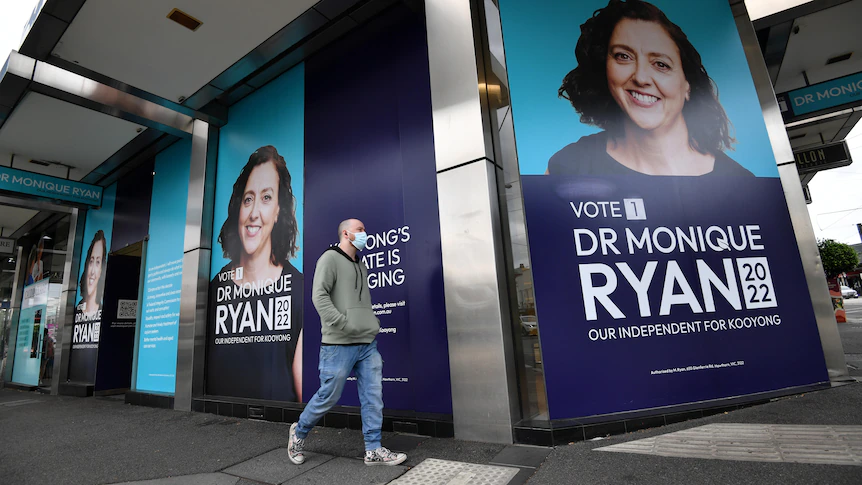When I was 12, Julia Gillard was the Australian prime minister and Barack Obama was the US President. At my young age, I thought that this image of leadership was normal, standard, nothing out of the ordinary.
How wrong I was.
Looking back, the political landscape seemed to be finally opening up. That’s why it’s surprising, and disappointing, that the wins since then have been few and far between.
Parliament continues to be dominated by wealthy white men. For a young Asian-Australian woman like me, it is a visual reminder of who holds the power and who does not.
But we cannot get lost in pessimism. There is good reason to think this election will be a very different one. This time around, a record number of women are standing as independent candidates. If enough are successful, it could decide the next government.
In 2022, 49 female candidates have launched independent campaigns, almost double the number of the previous election. Most are calling for action on climate change, gender equality and an end to corruption in politics.
Among the frontrunners aiming for Liberal aligned seats are Monique Ryan against Josh Frydenberg in Kooyong, Zoe Daniel against Tim Wilson in Goldstein, Sophie Scamps against Jason Falinski in Mackellar, Allegra Spender against Dave Sharma in Wentworth and Kylea Tink against Trent Zimmerman in North Sydney.
Why are so many women putting their hands up to run?
The main reason, many of them say, is that the government has failed to take essential action on climate change. The Earth is on track to hit a 1.5C increase in about a decade. This will lead to irreversible devastation, including the submersion of low-lying Pacific states and frequent and severe floods, droughts and heatwaves that will affect billions more people.
Australia has repeatedly ignored these warnings. In 2021, we ranked last out of all developed nations for our greenhouse gas emissions and failure to move beyond fossil fuels. Both major parties have made little mention of climate change this election and have been criticised for their funding connections to oil and gas.
Allegra Spender, independent candidate for Wentworth, says she decided to run because she “could no longer watch from the sidelines”. She says the “next 10 years particularly for climate is crucial, and I believe we absolutely have to act now”.
Spender pledges to cut emissions by at least 50 per cent by 2030 and create a rapid transition to renewable energy. Other independents are pushing for an even higher 60-70 per cent emissions cut.
Demanding justice for survivors — and accountability
The government has also been heavily scrutinised for its failure to adequately address the culture of misogyny and sexual violence in Parliament. Last year, among other disclosures, Brittany Higgins alleged she was raped in Parliament House.
Liberal MP Christian Porter also faced an allegation of sexual assault when he was a teenager, which he strenuously denied.
Learning about these allegations was horrifying, but women did not turn away.
I joined with women young and old to march on Parliament House to protest the treatment of women and call for justice for survivors. It was not a feeling of optimism. It was a demand for accountability. We stood together, strong.
The number of women running in this election shows that this movement has not fallen away. Most independent candidates are pushing for policies that ensure the safety, equity and respect of women, including the full implementation of the recommendations of the Jenkins Review to create a safer political culture.
Ensuring integrity in government
The final pillar of the independent movement is ensuring integrity in politics. Nearly half of Australians do not trust the government to do the right thing.
To fix this, many independent candidates are backing a strong and independent anti-corruption commission to ensure that politicians are always acting in the people’s best interests.
It seems conservatives are spooked. Former prime minister John Howard recently took a swipe, describing the teal candidates as “anti-Liberal groupies“. Ironically, the idea that a sustainable planet, gender equality and politics free from corruption is “anti-Liberal” is partly why many Liberal seats are under threat.
At the same time, the rise of independent candidates reveals deeper issues with our democracy. It is a problem that there is declining trust in our major political parties. It is also a problem that the burden of “fixing the men’s mess” is falling on women’s shoulders.
Nearly all independent women candidates in this election are white and wealthy. Having more women in parliament is progress, but it’s a reminder of how the political structure is built for the elite — those with social power, time, money and connections. For many Australians, running for politics is out of reach.
What gives me hope?
One of the few independent candidates from diverse backgrounds is Dai Le, an Asian-Australian woman who is standing for the seat of Fowler. Le decided to run after Labor MP Kristina Kenneally was parachuted in to the highly multicultural seat. Le says she had to take money from her mortgage to fund her campaign.
This is a common story for many independent candidates. Independent Senator Jacqui Lambie had to sell her home so she could afford to run for the Tasmanian Senate and recalls burning through her savings and super in the process.
If “teal” independent women can shift the power in politics, imagine the country we could create if we had representatives from intersectional backgrounds, across race, age, disability, class and beyond?
Still, independent women in this election are demonstrating that women are not passive actors but forces of change in our democracy.
As a young woman and gender equality advocate, I am often asked what makes me hopeful when it comes to politics. My answer is simple: I truly believe that what happens on the ground will eventually shape what happens up on the hill.
The rise of independent women is proving just that.

Source:abc.net.au

